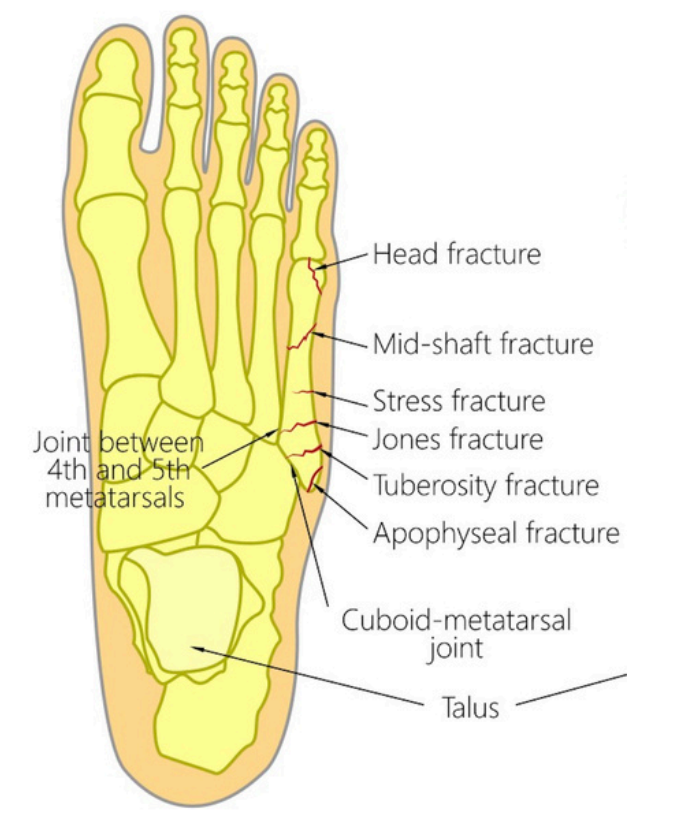Fifth Metatarsal Fracture
What is a 5th Metatarsal Fracture?
The metatarsal bones are the long bones in your feet. There are five metatarsal bones in each foot. The fifth metatarsal is the long bone outside the foot that connects to the small toe. The fifth metatarsal bone is more commonly fractured.

Three types of fractures often occur in the fifth metatarsal: avulsion fracture, Jones fracture and stress fracture. In an avulsion fracture, a piece of the bone is pulled off the main portion of the fifth metatarsal by the tendon that attaches to this region. Jones fracture involves a fracture in a small area of the fifth metatarsal that receives limited blood supply. These fractures are less common than those of avulsion fractures and may take longer to heal. A stress fracture (a small hairline break that occurs over time) occurs in a similar location to a Jones fracture but often occurs without trauma. These are difficult to heal without surgical intervention. Other fractures, such as mid-shaft fractures and fractures of the metatarsal head and neck, may occur in the fifth metatarsal.
Causes of a 5th Metatarsal Fracture
Outside of trauma, overuse, repetitive stress and an abnormal foot shape (see Cavovarus Foot Information Sheet) are the most common causes of Jones and stress fractures.
Symptoms of a 5th Metatarsal Fracture
Patients who sustain a 5th Metatarsal fracture have pain, swelling, tenderness, and bruising over the outside area of their foot. They may also have difficulty in walking.
Types of 5th Metatarsal Fractures
Due to the anatomy of the blood supply to the 5th metatarsal, different types of fractures are present and are managed differently.
- Apophyseal/avulsion/tuberosity fracture: usually occurs after a fall or twisting injury and usually heals without surgery due to a good blood supply; wearing a moonboot may help with pain relief
- Jones fracture: This fracture often occurs after an injury and is less common than an avulsion fracture. Surgery is often recommended as it does not have a good blood supply and sometimes does not heal.
- Stress fracture: Can occur without any trauma with repetitive weight-bearing or an underlying condition. Surgery is recommended as it often does not heal due to a poor blood supply.
- Midshaft/head fracture: Occurs after a trauma and usually heals without surgery due to a good blood supply; wearing a moonboot may help with pain relief
Diagnosis of a 5th Metatarsal Fracture
If you injure your fifth metatarsal bone, you should seek medical attention immediately for proper diagnosis and treatment. Dr Graff will ask you about the symptoms and history of injury and will examine your foot to determine the location of the pain. X-rays and other additional imaging studies may be needed.
Management and Treatment of a 5th Metatarsal Fracture
Initial treatment consists of rest, ice, compression, and elevation (RICE protocol), which all help control pain and swelling.
A cast, cast boot, or stiff-soled shoe may be needed to immobilise your foot. Crutches may be recommended to prevent you from putting weight on your leg. Surgery is often recommended for Jones and stress fractures to encourage them to heal due to their poor blood supply. Equally, if the fracture fails to unite or heal with non-surgical methods, surgery will likely be recommended.
Surgery may include placing a screw to stabilise the fractured bone and hold it securely in place while healing occurs, and bone graft may be used to stimulate a healing response. This is often needed for Jones fractures and stress fractures (see 5th Metatarsal Fracture Fixation Surgery). Dr Graff will discuss the type of procedure needed for your condition.
